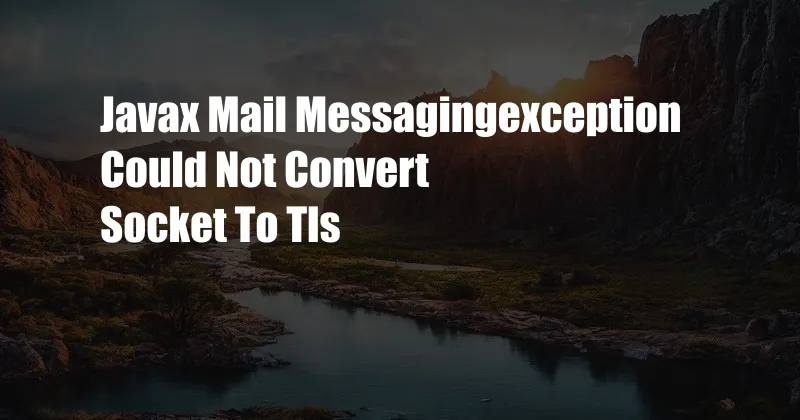
javax.mail.MessagingException: Could Not Convert Socket to TLS
In the vast expanse of email communication, the javax.mail API stands tall as a reliable framework for sending and receiving messages. However, even within this robust framework, exceptions can arise, one such being the dreaded ‘javax.mail.MessagingException: Could not convert socket to TLS’.
This exception surfaces when an attempt is made to establish a secure connection using Transport Layer Security (TLS) but fails. TLS, the successor to SSL, safeguards email transmissions by encrypting data, ensuring privacy and integrity. When this conversion fails, it can severely impede email communication, prompting the need for immediate troubleshooting.
TLS Configuration Woes
The root cause of this exception often stems from misconfigured TLS settings. Email servers require proper TLS configuration to enable secure connections. If the server’s TLS settings are incorrect or outdated, the client will be unable to establish a secure connection, resulting in the ‘Could not convert socket to TLS’ error.
To resolve this issue, it is imperative to ensure that the email server’s TLS settings are up-to-date and configured correctly. This may involve updating certificates, enabling the appropriate TLS protocol versions, and verifying that the server’s hostname matches the certificate’s Common Name (CN).
Client-Side Configuration Quandaries
In some instances, the ‘Could not convert socket to TLS’ exception may originate from the client-side configuration. Email clients, such as JavaMail, rely on specific TLS settings to establish secure connections. Incorrect or outdated TLS settings on the client side can also lead to this exception.
To rectify this issue, it is essential to verify that the TLS settings in the email client align with those of the email server. This may involve enabling the appropriate TLS protocol versions and ensuring that the client trusts the server’s certificate.
Network and Firewall Constraints
Network and firewall configurations can also contribute to the ‘Could not convert socket to TLS’ exception. If the network or firewall is blocking the TLS connection, the client will be unable to establish a secure connection with the email server.
To address this issue, it is necessary to ensure that the network and firewall allow connections on the appropriate TLS ports. Additionally, any firewalls or intrusion detection systems should be configured to allow TLS traffic.
Tips for Troubleshooting
To effectively troubleshoot the ‘javax.mail.MessagingException: Could not convert socket to TLS’ exception, follow these expert tips:
- Verify TLS Settings: Ensure that the TLS settings on both the email server and the email client are correct and up-to-date.
- Check Network and Firewall Configurations: Confirm that the network and firewall configurations allow TLS connections on the appropriate ports.
- Update Certificates: If the SSL/TLS certificates have expired or are otherwise invalid, update them with valid certificates.
Frequently Asked Questions (FAQs)
- Q: Why am I getting the ‘Could not convert socket to TLS’ exception?
- Q: How can I troubleshoot this exception?
- Q: What are the potential causes of misconfigured TLS settings?
A: This exception occurs when an attempt to establish a secure TLS connection fails, often due to misconfigured TLS settings, client-side configuration issues, or network/firewall constraints.
A: Verify TLS settings on both the server and client, check network and firewall configurations, and update certificates if necessary.
A: Outdated TLS protocol versions, incorrect certificate configurations, and hostname mismatches can all contribute to misconfigured TLS settings.
Conclusion
The ‘javax.mail.MessagingException: Could not convert socket to TLS’ exception can be a frustrating obstacle in email communication. By understanding the underlying causes, including TLS configuration issues, client-side misconfigurations, and network constraints, you can effectively troubleshoot and resolve this exception, ensuring seamless and secure email communication.
If you are facing this exception and the provided tips and FAQ have not resolved your issue, it may be necessary to delve deeper into the specifics of your email server, client, and network configurations. Don’t hesitate to consult with your email provider, network administrator, or software vendor for further assistance.